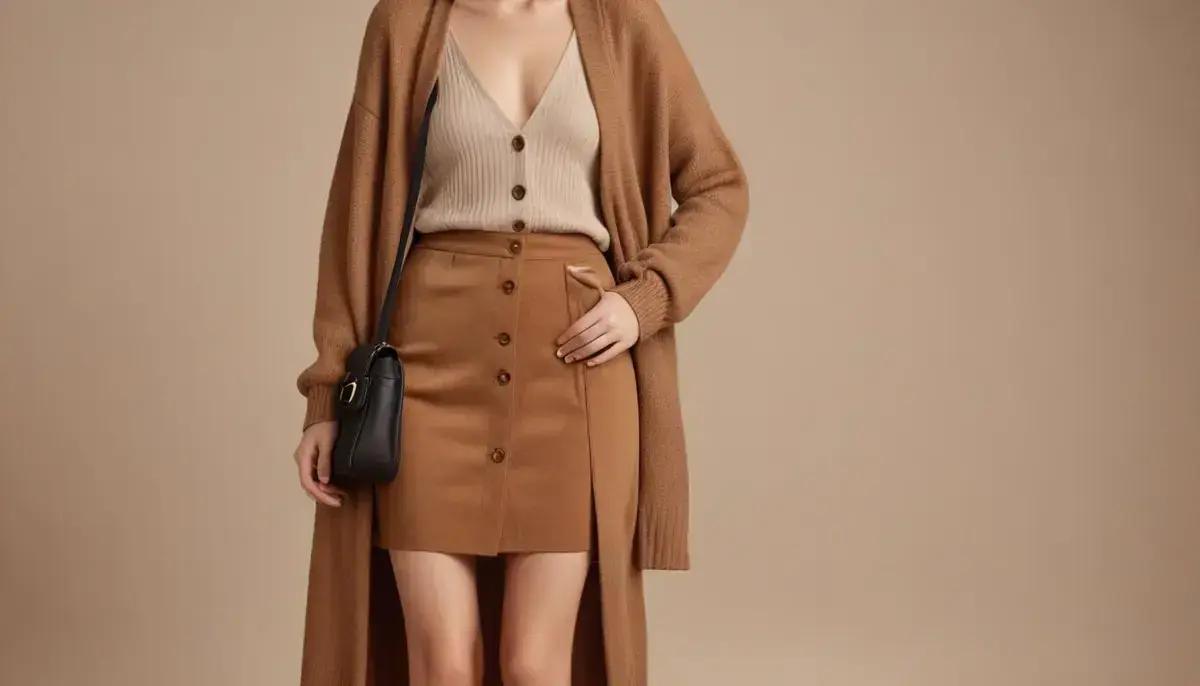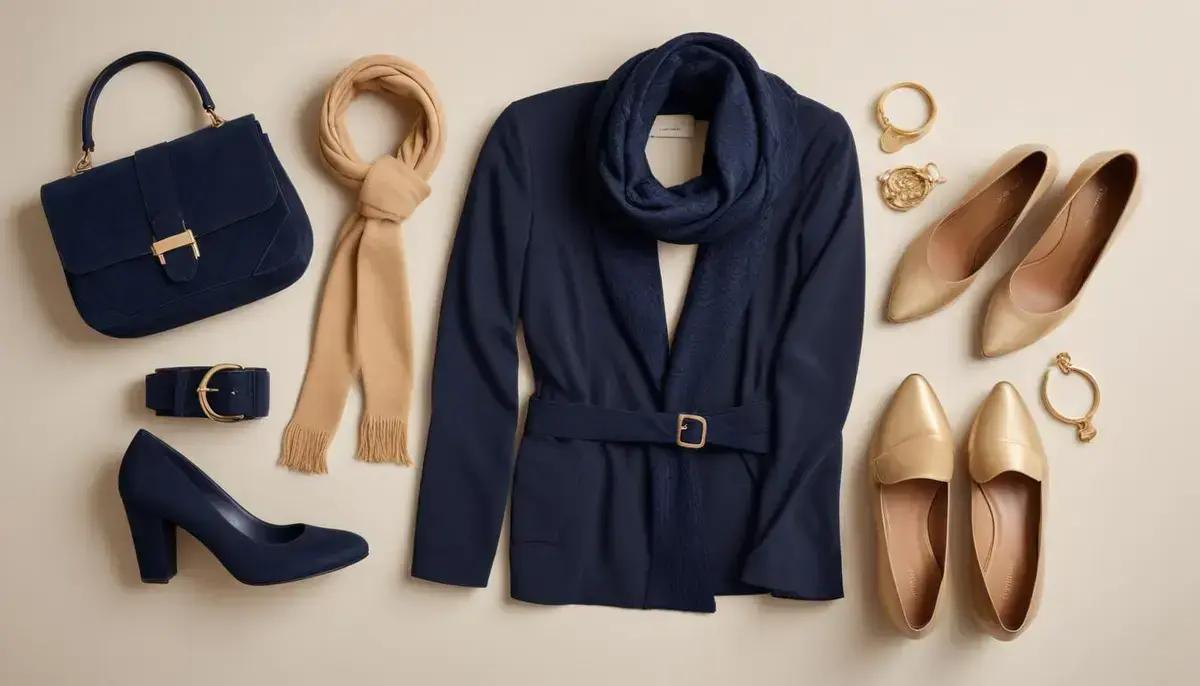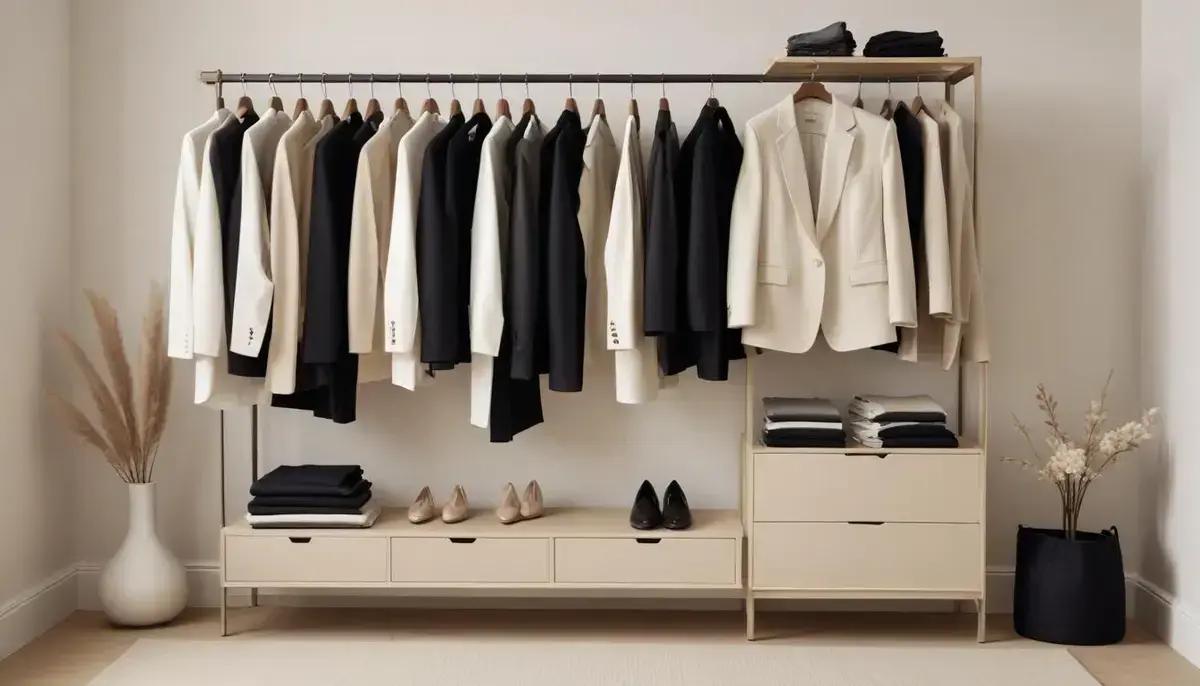The monochrome trend has evolved far beyond the classic black-and-white combination we all know. Today’s fashion-forward approach embraces single-color styling across the entire spectrum, creating sophisticated looks that speak volumes about your personal style. Whether you’re drawn to rich burgundy, soft sage, or bold navy, mastering monochrome dressing can transform your wardrobe into a curated collection of effortless elegance.
What defines the modern monochrome trend
The modern monochrome trend goes beyond simply wearing one color from head to toe. It’s about creating depth and interest through texture, shade variation, and silhouette. Unlike traditional black-and-white monochrome, today’s approach embraces the full color spectrum while maintaining a cohesive single-color theme.
Key Elements of Contemporary Monochrome
Modern monochrome styling incorporates three crucial elements: tonal variation (using different shades of the same color), mixed textures (combining fabrics like leather, silk, and knit), and intentional proportions (playing with volume and structure). This creates visual interest while maintaining a streamlined look.
Designers are pushing boundaries by experimenting with unexpected colors like mustard yellow, deep teal, or soft lavender in monochrome outfits. The trend has expanded to include accessories, shoes, and even makeup in coordinating tones.
Why It Works
This approach to monochrome dressing creates an instantaneously polished appearance while allowing for personal expression. It simplifies decision-making (no color matching required) yet offers endless creative possibilities through material combinations and styling techniques.
The modern interpretation also considers skin undertones and personal coloring more carefully than ever before. Instead of defaulting to black, fashion-forward individuals are selecting their monochrome palette based on what flatters their natural features.
Single-color styling beyond black and white
Moving beyond black and white, single-color styling opens up a world of sophisticated fashion possibilities. Rich jewel tones like emerald green or deep sapphire create striking monochrome statements, while earthy neutrals like terracotta or olive offer subtle elegance.
Choosing Your Signature Color
The key to successful single-color styling lies in selecting a hue that complements your skin tone and personal style. Cool complexions shine in blues and purples, while warm undertones glow in rusts and mustards. Don’t be afraid to experiment with unconventional choices like lavender or ochre for unexpected impact.
Texture mixing becomes even more important with colored monochrome looks. Combine a satin blouse with wool trousers and suede boots in the same color family to create visual interest. The variation in materials prevents the outfit from looking flat while maintaining cohesion.
Seasonal Color Adaptations
Single-color styling adapts beautifully across seasons. Transition from summer’s powder blue linen sets to autumn’s burgundy velvet ensembles. Winter calls for deep charcoal or chocolate brown head-to-toe looks, while spring blossoms with pastel monochrome in blush pink or mint green.
Accessories play a crucial role in colored monochrome outfits. Match your bag and shoes in slightly different tones of your main color, or add metallic accents in similar hues for dimension. The modern approach allows for tone-on-tone patterns like pinstripes or subtle plaids within your chosen color family.
How to build a monochrome wardrobe foundation
Building a monochrome wardrobe foundation starts with selecting versatile base pieces in your most flattering neutral. Begin with three core items: a tailored blazer, straight-leg trousers, and a classic turtleneck in matching tones. These form the backbone for countless sophisticated outfits.
Essential Pieces to Invest In
Prioritize quality over quantity when building your monochrome base. Look for:
✔️A well-fitted coat in your signature shade
✔️Two pairs of pants (one dressy, one casual)
✔️Three tops with different necklines
✔️A midi dress or jumpsuit for effortless dressing
Stick to the same color family for maximum mix-and-match potential.
Fabric selection matters tremendously in monochrome dressing. Choose wrinkle-resistant materials that maintain their shape and color through multiple wears. Wool blends, high-quality cotton, and technical fabrics work particularly well for foundational pieces.
Building Out Your Palette
Once you’ve established your neutral base, gradually introduce textured pieces and tonal variations to add dimension. A cashmere sweater in a slightly lighter shade or leather pants in a deeper tone create interest while maintaining cohesion. Remember that monochrome doesn’t mean identical – aim for pieces that are close enough to harmonize but varied enough to create depth.
Accessories should follow the same color rules but can play with finish. Matte and shiny versions of your base color, or metal hardware in complementary tones, add polish without breaking the monochrome effect.
Texture mixing techniques for monochrome outfits

Mastering texture mixing is the secret to creating monochrome outfits that look expensive and intentional. The key is combining at least three different fabric types in the same color family – think a chunky knit sweater with silky trousers and suede ankle boots for instant dimension.
Texture Pairing Principles
Follow these guidelines for harmonious texture combinations:
✔️ Pair matte with shiny (wool blazer with satin blouse)
✔️ Combine heavy with light (denim jacket with chiffon dress)
✔️ Mix smooth with textured (leather pants with cable-knit sweater)
This creates visual interest while maintaining color cohesion.
Don’t overlook smaller textural details that elevate monochrome looks. Embellishments like beading, embroidery or quilting add subtle variation. Even hardware choices (matte vs polished buttons, zippers vs snaps) contribute to the overall textural story of your outfit.
Seasonal Texture Strategies
Adapt your texture mixing to the weather:
✔️ Winter: Layer wool, cashmere and shearling
✔️ Spring: Combine linen, eyelet cotton and raffia
✔️ Summer: Mix lightweight silk, gauze and seersucker
✔️ Fall: Blend corduroy, suede and merino wool
This approach keeps your monochrome looks seasonally appropriate while maximizing textural contrast.
When accessorizing textured monochrome outfits, let your clothing textures guide your choices. Pair a smooth leather dress with a woven straw bag, or style a nubby tweed suit with glossy patent shoes for perfect balance.
Color psychology in monochrome fashion choices
The psychology of color plays a crucial role in monochrome fashion, influencing both how you feel and how others perceive you. Wearing a single color head-to-toe amplifies its psychological impact, making your choice of hue more significant than in multi-colored outfits.
Power Colors for Different Intentions
Different monochrome palettes convey distinct messages:
✔️ Navy blue projects authority and trustworthiness
✔️ Deep red communicates confidence and energy
✔️ Soft pink suggests approachability and creativity
✔️ Charcoal gray appears sophisticated and balanced
Choose your monochrome color based on the impression you want to make.
Your skin’s undertones significantly affect how color psychology works in monochrome dressing. Cool undertones harmonize with jewel tones like emerald and sapphire, while warm undertones shine in earth tones like terracotta and olive. The right hue will make you appear healthier and more vibrant.
Contextual Color Choices
Consider these psychological effects for specific situations:
✔️ Job interviews: Medium blues project reliability
✔️ Creative meetings: Unexpected hues like violet show innovation
✔️ First dates: Warm neutrals create approachability
✔️ Presentations: Red variations command attention
Remember that cultural associations may vary these effects internationally.
Seasonal color psychology also matters in monochrome fashion. Spring pastels feel rejuvenating, summer whites appear crisp and clean, autumn earth tones feel grounded, and winter darks project sophistication. Aligning with seasonal colors can make your monochrome looks feel more timely and appropriate.
Monochrome styling for different body types
Monochrome dressing can be incredibly flattering for all body types when styled strategically. The key is using the single-color palette to create optical illusions that highlight your best features while minimizing areas you’re less confident about.
Styling Strategies by Body Shape
For apple shapes:
✔️ Use darker monochromes on top with slightly lighter bottoms
✔️ Choose V-necks and open collars to elongate the torso
✔️ Add structured jackets that nip at the waist
For pear shapes:
✔️ Balance proportions with lighter tops and darker bottoms
✔️ Incorporate shoulder details to widen the upper body
✔️ Select A-line skirts and wide-leg pants in your monochrome hue
Universal Monochrome Tricks
Several techniques work for all body types:
✔️ Vertical lines created by long cardigans or coats
✔️ Strategic draping that follows your natural curves
✔️ Tonal belts to define the waist without breaking the line
✔️ Asymmetrical hemlines that draw the eye vertically
Petite frames benefit from head-to-toe light monochromes to create length, while taller individuals can play with bold color blocking within their single-color palette. Remember that fabric choice matters just as much as color – flowy fabrics create movement, while structured pieces provide definition.
Seasonal monochrome palettes and color selection
Adapting your monochrome palette to the seasons keeps your looks fresh and weather-appropriate. Each season calls for specific color families that complement both the environment and seasonal fabrics.
Spring Monochrome
Spring shines with pastel monochromes in:
✔️ Soft lavender
✔️ Powder blue
✔️ Blush pink
✔️ Mint green
Pair these with lightweight fabrics like linen and chiffon for airy elegance.
Summer Monochrome
Summer calls for crisp brights and neutrals:
✔️ Stark white
✔️ Sky blue
✔️ Lemon yellow
✔️ Coral
Opt for breathable cotton, eyelet, and seersucker textures.
Fall Monochrome
Autumn welcomes earthy tones in:
✔️ Rust
✔️ Olive green
✔️ Mustard yellow
✔️ Chocolate brown
Layer with textured wools, suede, and corduroy for cozy sophistication.
Winter Monochrome
Winter demands rich deep tones like:
✔️ Charcoal
✔️ Burgundy
✔️ Forest green
✔️ Navy
Combine with luxe fabrics such as velvet, cashmere, and wool for warmth.
Transition between seasons by gradually shifting shades within your color family. For example, move from summer’s bright white to winter’s creamy ivory through autumn’s oatmeal tones.
Accessories that enhance monochrome looks

The right accessories can elevate a monochrome outfit from simple to stunning. When working with a single-color palette, accessories become crucial for adding dimension and personality without breaking the cohesive look.
Essential Monochrome Accessories
These pieces work with any monochrome palette:
✔️ Textured belts in matching tones
✔️ Statement bags with interesting hardware
✔️ Minimalist jewelry in complementary metals
✔️ Patterned scarves in tonal prints
Each should harmonize with your base color while adding visual interest.
Material Mixing for Impact
Play with different materials within your color scheme:
✔️ Pair a suede handbag with a silk dress
✔️ Combine patent shoes with matte trousers
✔️ Mix metallic jewelry with knitwear
This creates depth while maintaining color consistency.
For a modern twist, try monochrome pattern mixing – pair pinstriped pants with a polka dot scarf in the same color family. The key is keeping the scale of patterns different and the color identical.
Shoe Strategies
Shoes can make or break a monochrome look:
✔️ Match exactly for leg-lengthening effect
✔️ Go slightly darker for grounded elegance
✔️ Try metallic tones for evening glam
✔️ Use contrasting textures (like patent with matte) for interest
Don’t forget small details like buttons, zippers, and stitching – these subtle touches can add sophistication to your monochrome ensemble when carefully coordinated.
Professional monochrome styling for workplace
Professional monochrome styling creates powerful, polished workplace looks that command respect while maintaining versatility. The key is balancing sophistication with approachability through strategic color choices and tailored silhouettes.
Corporate Color Selection
Opt for these professional-friendly monochrome palettes:
✔️ Charcoal to light gray gradient
✔️ Navy blue spectrum
✔️ Camel to chocolate brown tones
✔️ Deep burgundy variations
These colors project authority while remaining office-appropriate.
Tailoring Techniques
Professional monochrome demands impeccable fit:
✔️ Structured blazers with defined shoulders
✔️ Straight-leg trousers with clean lines
✔️ Knee-length skirts or dresses
✔️ Crisp button-downs with minimal detailing
Tailoring should enhance your shape without being restrictive.
Layer different textures of the same color for depth – pair a wool blazer with a silk shell and twill pants. This maintains professionalism while adding visual interest through material contrast.
Accessory Guidelines
Work-appropriate accessories should:
✔️ Complement without distracting (think thin gold bangles or simple studs)
✔️ Include a structured leather bag in matching tones
✔️ Feature closed-toe pumps or loafers in coordinating shades
✔️ Use minimal, elegant jewelry to polish the look
For client meetings, consider a tonal patterned scarf or textured tie to add personality while maintaining professionalism. Keep makeup and grooming equally polished to complete your executive monochrome aesthetic.
Casual monochrome outfits for everyday wear
Casual monochrome outfits offer effortless style for daily wear while maintaining a put-together aesthetic. The secret lies in balancing comfort with intentional styling through fabric choices and relaxed silhouettes.
Weekend Essentials
Build your casual monochrome wardrobe with:
✔️ Soft cotton tees in neutral tones
✔️ Relaxed denim in uniform washes
✔️ Oversized sweaters in cozy knits
✔️ Structured joggers in linen or cotton
These basics mix and match seamlessly for easy dressing.
Texture Play
Elevate simple looks with thoughtful texture combinations:
-✔️ Pair a slub cotton tee with brushed denim
-✔️ Combine a chunky cardigan with silk joggers
-✔️ Layer a knit polo over corduroy shorts
This creates visual interest while keeping the color story clean.
For summer casual wear, try head-to-toe white in varying shades and fabrics – think an ecru linen shirt with oyster-colored shorts and bone sneakers. The tonal variation keeps it from looking too stark.
Shoe Pairings
Complete your casual monochrome looks with:
✔️ Minimalist sneakers in matching tones
✔️ Slides in coordinating leathers
✔️ Espadrilles for summer vibes
✔️ Chelsea boots for transitional weather
Keep footwear in the same color family but vary materials for dimension.
Accessorize with natural fiber hats, woven belts, and simple jewelry that enhance without overpowering your laid-back monochrome aesthetic.
Common monochrome styling mistakes to avoid
While monochrome styling creates sleek, sophisticated looks, certain common mistakes can undermine the effect. Being aware of these pitfalls helps you master single-color dressing with confidence.
Color Matching Errors
Avoid these color coordination missteps:
✔️ Mismatched undertones (cool vs warm versions of the same color)
✔️ Overly matchy-matchy pieces that look like a uniform
✔️ Ignoring skin tone when selecting your monochrome palette
Instead, aim for harmonious variations within your chosen color family.
Texture Troubles
Steer clear of these texture mistakes:
✔️ Using only flat, matte fabrics that appear one-dimensional
✔️Combining too many competing textures that create visual chaos
✔️ Forgetting to vary fabric weights for seasonal appropriateness
The ideal monochrome look balances 2-3 complementary textures.
Many people make the error of neglecting proportions in monochrome outfits. Without color blocking to define shape, poorly balanced silhouettes can appear overwhelming. Always consider how each piece’s cut and volume work together.
Accessory Blunders
Common accessory mistakes include:
✔️ Over-accessorizing with too many competing pieces
✔️ Choosing clashing metals that distract from the color story
✔️ Wearing wrong shoe colors that break the vertical line
Keep accessories minimal and in the same tonal family for cohesion.
Finally, don’t fall into the trap of thinking monochrome means boring or limited. With creative texture play and thoughtful styling, single-color outfits offer endless sophisticated possibilities.
Shopping tips for monochrome wardrobe essentials

Building a versatile monochrome wardrobe requires strategic shopping to create maximum mix-and-match potential. Focus on quality basics that work together seamlessly while allowing for personal style expression.
Foundational Pieces to Prioritize
Invest first in these essential categories:
✔️ Tailored separates (blazers, trousers, skirts)
✔️ Neutral tops in multiple sleeve lengths
✔️ Year-round dresses in classic silhouettes
✔️ Quality outerwear in your signature shade
Choose fabrics that resist pilling and fading for longevity.
Smart Shopping Strategies
Follow these tips when building your monochrome collection:
✔️ Shop by color family rather than exact matches
✔️ Check fabric content for durability and drape
✔️ Consider care requirements for easy maintenance
✔️ Look for tonal stitching and subtle details
✔️ Buy multiples of perfect basic items
When evaluating potential purchases, ask yourself:
✔️ Does this work with at least 3 other items I own?
✔️ Is the color versatile across seasons?
✔️ Will the fabric hold up to regular wear?
✔️ Does it fit my lifestyle needs?
Budget Allocation Advice
Distribute your spending wisely:
✔️ Splurge on outerwear and tailored pieces
✔️ Invest in quality shoes and bags
✔️ Save on trendier accessories and tops
Remember that monochrome dressing rewards fewer, better-quality items over fast fashion purchases.
For online shopping, always order multiple shades of the same item to compare in person, as screen colors can be deceiving. Keep a fabric swatch or paint chip of your ideal neutral when shopping in stores.
Mastering the Monochrome Trend
The monochrome trend offers endless possibilities for creating sophisticated, stylish looks that stand the test of time. By understanding color psychology, playing with textures, and selecting the right pieces for your body type, you can build a versatile wardrobe that works for any occasion.
Remember that successful monochrome styling isn’t about wearing identical shades from head to toe, but rather creating harmonious outfits with depth and intention. Whether dressing for the office or weekend outings, a well-curated monochrome collection simplifies decision-making while maximizing your style impact.
Start small with neutral foundations, then gradually experiment with color and texture combinations as your confidence grows. With these principles in mind, you’ll discover how single-color dressing can become your secret weapon for effortless elegance every day.






